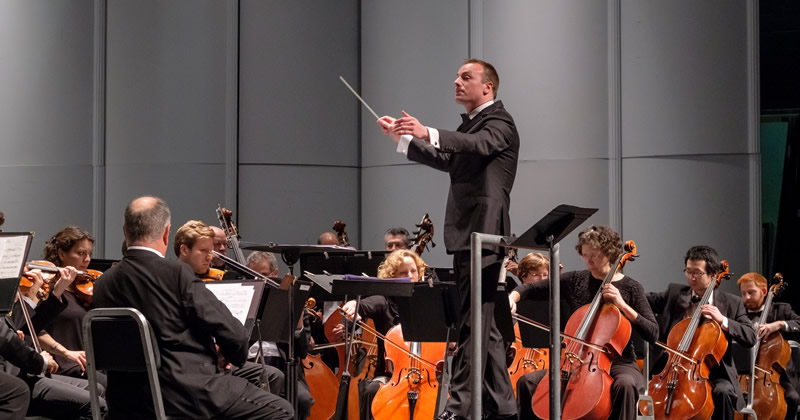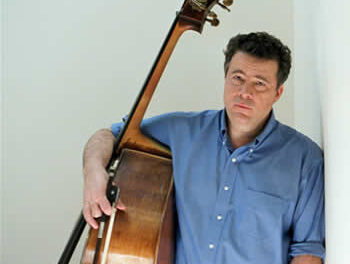With this official season opener, in Chapel Hill, the North Carolina Symphony marked the first concert of its statewide tour. This program was conducted by associate conductor, Wesley Schulz.
After Schulz opened the concert with greetings, the audience, accompanied by the orchestra, sang the “Star-Spangled Banner.” The evening’s program proceeded with Mozart’s Symphony No. 31 in D (“Paris”), K. 297/300a (1778). Cast in only three movements (no minuet), the work is full of starkly contrasting materials moving from very soft passages to very loud sections, often with technically difficult passage work. The conductor and players handled these pyrotechnics with fine precision and ease. Some of these effects spanned a relatively long time; meanwhile, there were shorter figures occurring concurrently that might have been explored for their short-term contribution to elements of interest with articulations and emphases on certain notes. This compositional style was attractive to the Parisian audiences, and, in hopes of winning a musical post, Mozart was writing to please them!
The second work of the evening came from the pen of a Welsh composer, Grace Mary Williams (1906-77), titled Sea Sketches (1944). She wrote, “I have lived most of my life by the sea, and will never tire of looking at it and listening to its wonderful sounds.” (It is interesting to note that music director Grant Llewellyn‘s hometown is less than a mile from Williams’ former home in Wales.) In this composition, Williams demonstrates her exquisite skills in portraying aspects of the sea – high winds, sailing, channel sirens, breakers, and a calm sea in summer. For me, her considerable gifts in orchestration readily turned orchestral sounds into the images she was portraying. Her compositional style is direct and succinct – not a wasted moment anywhere. The NCS, well-led, played with great gusto and precision. Pure delight this was!
Edward Elgar’s popular Variations on an Original Theme, Op. 36 (a.k.a. “Enigma Variations”), was given the berth of the last work on the program. Elgar dedicated this work to “my friends pictured within.” In this theme and variations, he portrays the emotional characteristics of these friends with deft artistry. He had honed this skill by first improvising this type of impressions at the piano, as did Vincent Persichetti in his later years when working with groups of students. (The students were delighted to have been heard at this level.) Following a simple statement of the theme, Elgar proceeds into fourteen variations depicting the emotional characteristics of his wife (Variation I) and himself, in the Finale (Variation XIV). Scholars seem to have identified the names of the friends, identified in the score only by their initials, for the most part.
Variation IX, however, is titled “Nimrod,” likely a reference to the Nimrod found in the first books of the Old Testament as a mighty hunter. Christine Martin, a long-time member of the NCS viola section, shares her impression of this variation: “I believe the slow movement of the Enigma Variations, “Nimrod,” is one of the most beautiful melodies ever written by any composer.”
Eric McCracken, a long-time first violinist in the NCS, expressed his thoughts about the Variations: “The Enigma Variations, while a challenging virtuosic work, is a favorite of mine and always a pleasure to perform. Elgar ingeniously creates an array of musical vignettes, each of which describe the unique and contrasting personalities of his friends. By utilizing the underlying theme, Enigma, for each portrait, he weaves together a coherent musical tapestry.”
Schulz guided the players through the labyrinth of the numerous variations with great skill, handling the abrupt changes of moods with confidence. The players locked well into his leadership and delivered a delightful performance. Two players deserve special mention for their exquisite sound in brief solos: Samuel Gold, principal viola, and Bonnie Thron, principal cello.
The four North Carolina Symphony Mozart/Elgar concerts take place between Thursday, September 26 and Sunday, October 4. These include performances in Chapel Hill, Wilmington, Southern Pines, and New Bern. For more on these performances, see the sidebar.
The North Carolina Symphony, the first state-supported symphony in the country, performs under the auspices of the North Carolina Department of Natural and Cultural Resources. The North Carolina Symphony’s musicians, full-time professionals, perform under the artistic leadership of music director Grant Llewellyn.












